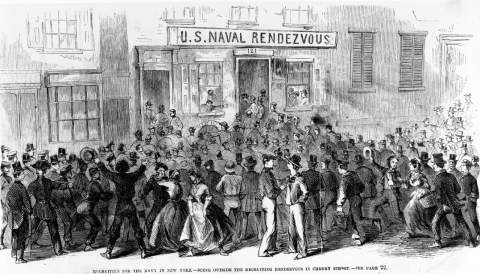The mammoth contribution of New York to the armies of the United States is a topic on which much ink has been spilled. Less well known is the central role that the Empire City and State played in bringing victory in the War on the Waters. It is difficult to overstate the importance to the U.S. Navy of locations such as the Brooklyn Navy Yard, where so many vessels were constructed, outfitted, and repaired. But New York, and in particular New York City, was also the key provider of the Navy’s most vital commodity—manpower. Nowhere supplied more “Bluejackets” for the decks and engine rooms of the rapidly expanding Union fleets than did New York, a service in which c. 118,000 men ultimately served.
The majority of these naval recruits were drawn from the lower echelons of New York society—individuals whose life-detail has proved particularly challenging for us to uncover. But it is to our great benefit that the Navy created copious amounts of records relating to these men—data that allows us to follow them from initial enlistment to on-board service, and often into the post-war decades in the form of pension records. In contrast to the army documentation, the majority of these records have now also been digitized, creating a unique opportunity which the Civil War Bluejackets Project hopes to capitalize on.
The aim of the Civil War Bluejackets Project is to create new resources for historians and genealogists interested in the backgrounds and experiences of these Civil War sailors, and to use them to expand our knowledge of this fascinating group of men. Launched in September 2022, the project is funded by the UK Arts and Humanities Research Council and is a collaboration between historians at Northumbria University and information scientists at the Universities of Sheffield and Koblenz-Landau, together with partners such as the United States Naval Academy Museum.
At the heart of Civil War Bluejackets is a call for citizen volunteers to aid in the transcription of tens of thousands of wartime muster sheets. Held at the National Archives, these recently digitized musters were taken every three months aboard U.S. vessels throughout the conflict. They contain a remarkable level of detail about the men who made up individual ships’ crews—detail we want to use to capture both the sailor’s personal information and to recreate their shipboard communities.
We are recording 12 pieces of information about each sailor, including things like their names, ages, nativity, and pre-service occupations. We can then place this detail within the context of the specific vessel on which they were serving. At a macro-level, this information will allow us to analyze how shipboard communities differed, how they changed through time, and how those changes might have impacted sailors’ experience of service. At a micro-level, it will allow us to explore the stories of men from places like New York City, revealing significant new detail about the large number of working-class urban men, immigrants and African Americans who enlisted in the U.S. Navy.
At the project’s conclusion, we will use the information our citizen volunteers gather to create a new freely available database of these sailors, which we hope to expand and link to other naval records, such as enlistment rendezvous reports and pension files. When completed, it will provide historians and genealogists alike an opportunity to explore the social and military backgrounds and experiences of these men in ways never before possible. In addition to this historical and genealogical component, the Civil War Bluejacket information scientists also aim to utilize volunteer contributions in the development of new software to facilitate the machine-reading of 19th century handwriting, something that could have significant and far-reaching applications.
In order to be a success, Civil War Bluejackets relies on our volunteer Citizen Scientists, who play the central role in transcribing individual muster sheets. Already more than 550 volunteers have “come aboard” to contribute to the project on the Zooniverse platform, but this is a number we hope to greatly expand. Anyone interested in participating can join our Bluejackets community at https://www.zooniverse.org/projects/bluejackets/civil-war-bluejackets. Once there, volunteers can choose which of the 12 different pieces of sailor information we are gathering they would like to focus on:
- “Names”
- “Ratings”
- “Where Born”
- “Occupation”
- “Age”
- “Where Enlisted”
- “Date of Enlistment”
- “Ship’s Number”
- “Term of Enlistment”
- “Remarks”
- “Eyes, Hair & Complexion”
- “Height”
Each classification is designed to take just a few minutes, as volunteers work on an individual sheet to transcribe and mark the location of words in an individual column. New volunteers can take advantage of a series of aids on our Zooniverse Page, including a tutorial, field guide and a Frequently Asked Questions section. We also have a dedicated forum, “Talk”, where volunteers can discuss discoveries and raise queries, and a YouTube channel with a series of “How To” videos.
We hope to spread word of the project as widely as possible and will be seeking to consistently share details of the data as it is revealed. To keep up to date with the latest Civil War Bluejackets news, you can check out our blog at www.civilwarbluejackets.com or follow us on Facebook, Instagram or Twitter. We hope you consider “climbing aboard” with us!
Damian Shiels, PhD, is a Post Doctoral Research Assistant with the Faculty of Arts, Design and Social Science at Northumbria University, and one of the researchers leading the Civil War Bluejackets Project.
